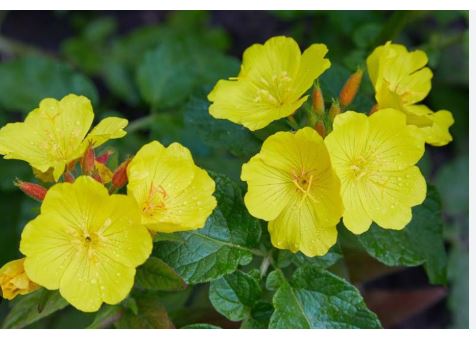
Oenothera biennis, commonly known as Evening Primrose, is part of the Oenothera genus within the Onagraceae family, which is also known as the evening primrose or willowherb family. This species is a biennial, meaning it completes its life cycle over two years, with the first year focused on vegetative growth and the second on flowering and seed production. It’s characterized by its large, yellow flowers that open in the evening.
Evening Primrose is native to North America, where its range includes most of the eastern and central United States, extending from Newfoundland in Canada west to Alberta, south to Florida, and west to Texas. It thrives in a variety of habitats, from meadows and roadsides to disturbed areas and forest edges, showing a preference for well-drained soils.
Historically, Oenothera biennis has been used by Native American tribes for both medicinal and nutritional purposes. Its roots, leaves, and seeds were consumed for their nutritional benefits, and it was used medicinally to treat various ailments including skin conditions and digestive issues. In Europe, where it was introduced in the 17th century, Evening Primrose became popular for ornamental gardening due to its night-blooming flowers and because its seeds are a source of evening primrose oil, which is used in supplements for various health benefits, though clinical evidence for these uses varies. The plant’s name reflects its habit of blooming in the evening, offering a spectacle to night-time observers.
Evening Primrose is adapted to USDA Hardiness Zones 4 through 9. This broad range allows it to grow in a variety of climates, from the colder parts of its native range to warmer, southern regions. Within these zones, it’s appreciated for its resilience in disturbed or poor soils, its ability to attract nighttime pollinators like moths, and its self-seeding nature which can lead to naturalization in landscapes. It’s often used in wildflower gardens, cottage gardens, or anywhere a touch of late-blooming color is desired, though it can be considered weedy in some contexts due to its prolific seed production.
Evening Primrose (Oenothera biennis): Characteristics
- Growth Habit: A biennial plant, it grows as a rosette of leaves in the first year, then flowers in the second year, reaching heights of 3 to 6 feet.
- Flowers: Produces large, showy yellow flowers with four petals, up to 2 inches across. Flowers open in the evening, hence the name, and close by mid-morning.
- Bloom Time: Flowers from late spring through to early fall, offering a long blooming period for a biennial plant.
- Leaves: Leaves are lance-shaped, toothed, and covered with fine hairs, giving them a slightly grey-green appearance. They grow alternately along the stem.
- Fragrance: The flowers have a sweet, subtle fragrance that becomes more pronounced at night, attracting nocturnal pollinators.
- Root System: Has a long taproot, which helps it to anchor well in soil and access deeper moisture, contributing to its drought tolerance once established.
- Seeds: Produces numerous seeds in long, cylindrical seed capsules following flowering. These seeds are a source of evening primrose oil.
- Adaptability: Highly adaptable to different soil types, preferring well-drained conditions but tolerant of poor, disturbed soils, which makes it common along roadsides and in waste areas.
- Pollinator Attraction: Attracts moths, bees, and other pollinators, particularly at night when its flowers are open, supporting nocturnal biodiversity.
- Ecological Role: Acts as a pioneer species in disturbed habitats, aiding in soil stabilization and providing food and habitat for wildlife. Its seeds and leaves can be consumed by birds and mammals.
Evening Primrose (Oenothera biennis): Cultivation
- Site Selection: Choose a location with full sun to partial shade. Evening Primrose performs best in full sun but can tolerate some shade, particularly in hotter climates.
- Soil Preparation: Prefers well-drained, sandy, or loamy soil. It can grow in poor, disturbed soils but thrives best with good drainage. Amend heavy clay soils with sand or compost.
- Planting: Sow seeds directly outdoors in late fall for natural stratification or in early spring after the last frost. Space plants or seeds 12 to 18 inches apart to allow for spread and air circulation.
- Watering: Water seeds after planting to ensure germination. Once established, it’s fairly drought-tolerant, requiring minimal watering unless there’s a prolonged dry spell.
- Mulching: Use a light mulch to retain soil moisture and suppress weeds but be cautious not to cover seeds too deeply if sowing directly. Mulch should not inhibit self-seeding.
- Fertilization: Fertilize sparingly since Evening Primrose can thrive in nutrient-poor soils. If soil is very poor, a light application of a balanced, slow-release fertilizer in spring might be beneficial.
- Pruning and Maintenance: Deadheading is not typically necessary since flowers produce seeds in capsules, but removing spent flower stalks can tidy the garden. Allow some seed pods to mature for self-seeding.
- Pest and Disease Management: Generally resistant to pests, but watch for aphids or caterpillars. Fungal diseases like powdery mildew can occur in overly wet conditions; ensure good air circulation and avoid overwatering.
- Propagation: Easily propagated by seeds, which should be sown where the plants are to grow, given their biennial nature. Division is less common but can be done in fall with root cuttings.
- Winter Care: In its second year, protect young plants from severe frost with a light mulch. In colder zones, the biennial cycle means new plants will emerge from seed in spring, so no special winter care is needed for the seeds.